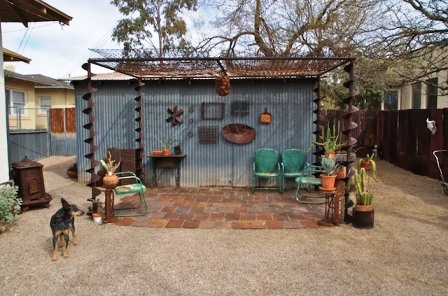Ramada
A whimsical, modern-day ramada provides shelter in Tucson, Arizona [(c) Scott Calhoun photograph]
ra·ma·da (n. Southwestern U.S.)
1. (a) An open or semi-enclosed shelter roofed with brush or branches, designed especially to provide shade. (b) An open porch or breezeway
2. An arbor or trellis made of twined branches.
No, people, it is not merely the name of the moderately-priced motel chain. But the hospitality industry has certainly popularized this regional appellation rooted in the Spanish word “rama” (meaning “branch”).
The architectural term “ramada” belongs in my Shed Glossary because it refers to a specific type of shelter in the landscape. Ramadas dot the backyards of the American Southwest. Adapted from Spanish, the term refers to an “open shelter roofed with brush or branches.” By extension, the term also describes a porch or breezeway. “Rama” is Spanish for “branch.” The suffix “-ada” denotes “a place characterized by (something).”
Translated, this means “an arbor or mass of branches.”
Scott Calhoun, garden writer, designer and speaker extraordinaire, of Tucson-based Zona Gardens, introduced me to the ramada as a stylish, shed-like design element. And he graciously shared the photograph above, which depicts the ramada’s modern-day architectural interpretation. Here’s what Scott has to say about it:
The story behind the shed is that my friend, Val Little, built it with friends for her birthday. It is made entirely of recycled objects. The posts are augers. The roof is of old bed springs and the pavers are from old Tucson water-meter lids. It is here in Val’s backyard in the historic West University neighborhood of Tucson. A couple of years ago I taught a “Junque” gardening class (with a tour) and we featured Val’s garden on the tour.
Living in Southern California, as is the case with Arizonans, the ramada has great appeal to me. It is the perfect shelter from sun and heat. I found a brief article about ramada design from Sunset magazine (1990). Here’s an excerpt:
Simple structures, rustic or modern, [ramadas] provide shelter from the sun and make sense in any climate. They can extend living space in seasons when it’s pleasant to be outdoors; or they can create a completely separate outdoor room. And they give instant sun control in new gardens, long before a tree can grow to shade-giving size.
Derived from a Spanish word meaning arbor, the ramada was traditionally erected by Native Americans as a shady resting place during the harvest. Built of mesquite or cottonwood poles and ocotillo stems, these shelters were open on at least three sides to take advantage of breezes.
I’ll be on the lookout for new examples of contemporary ramada designs. However, it’s hard to beat Val Little’s clever use of recycled augers (in place of ocotillo stems) and rusted bed springs (in place of branches overhead).









